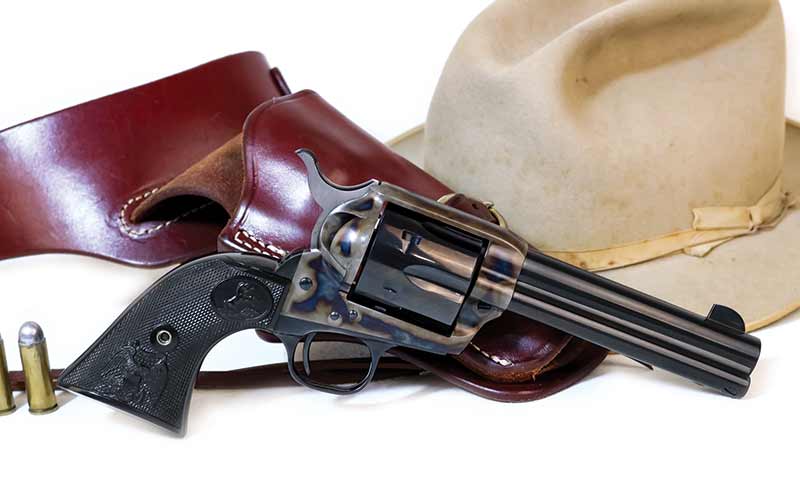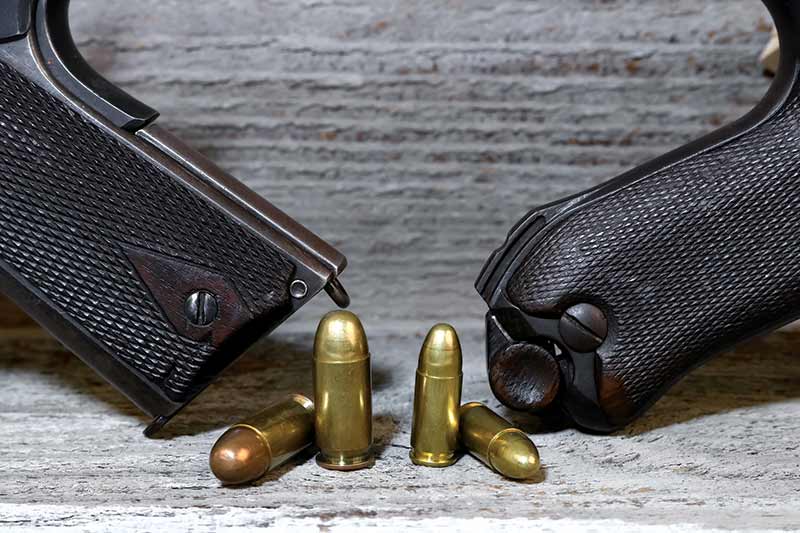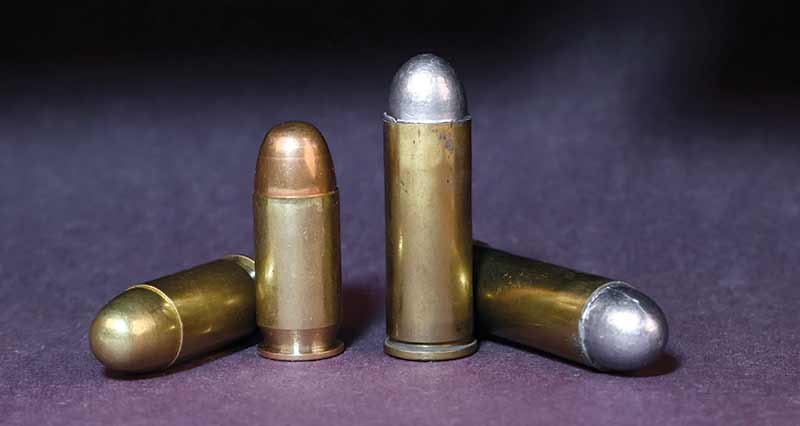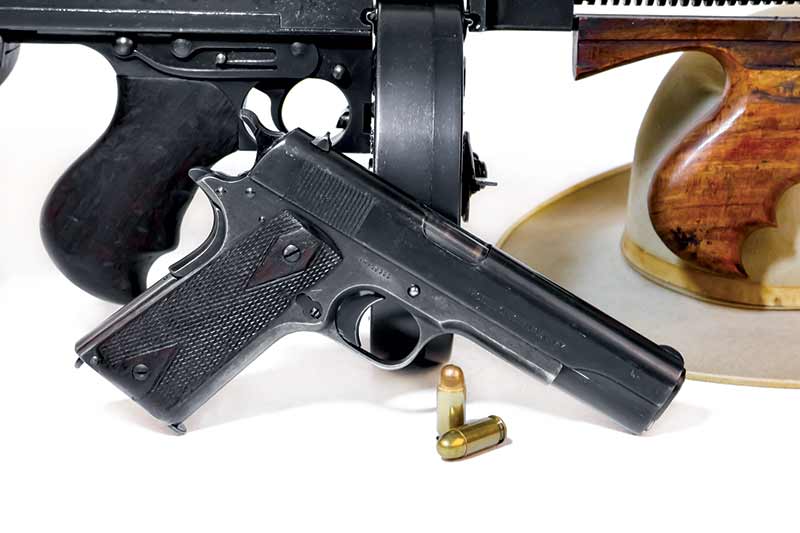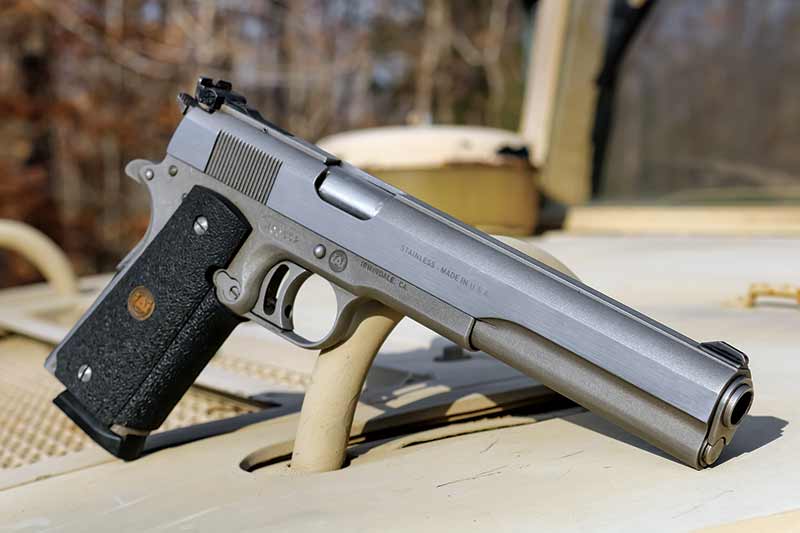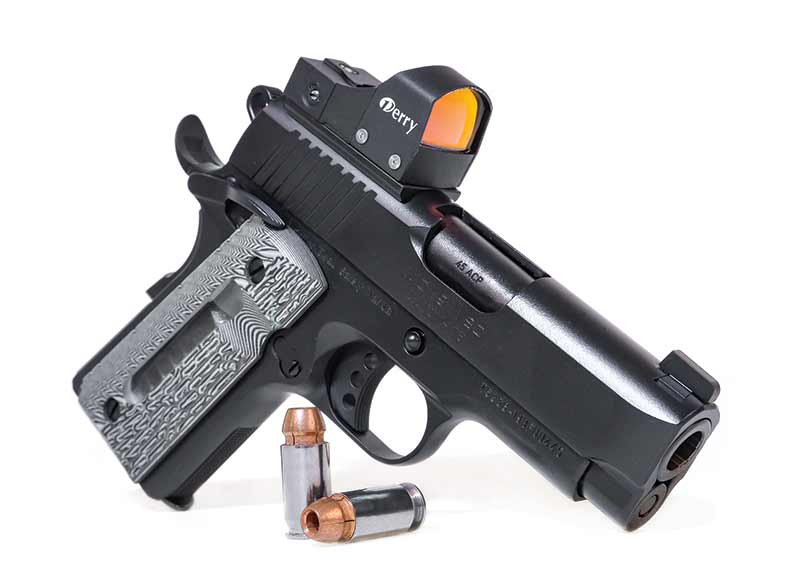Fantastic Voyage
The Meteoric Trajectory of America’s Bullet

Left: In 1926 the M1911 got a slight upgrade into the definitive M1911A1. This is
the weapon of American troops during WWII. Right: The pretty lady is Will’s wife’s
grandmother. This rig kept her Infantryman grandfather company from North Africa
through Sicily until the end of the war in Northern Italy.
Afriend was manning the .50 atop a gun truck in Afghanistan when his convoy was ambushed by Taliban insurgents. Heavy automatic weapons fire from multiple crew-served weapons raked their vehicles. The ear-shattering crump of RPGs split the morning. One moment they were rumbling peacefully down this remote dirt track and the next the whole world came crashing down on top of them. The bad guys were rapidly gaining fire superiority. Cutting through the adrenaline of the moment, my buddy began to feel serious fear.
Unbeknownst to my pal, while he had been throwing .50-caliber rounds as fast as he could feed his Ma Deuce his convoy commander had been working the radio. Amidst the deafening roar of outgoing fire and the terrifying rattle of the opposite sort there arose a fresh, new, unfamiliar racket. Two AH64D Apache gunships roared over the convoy close enough to touch, their 30mm Hughes M230 chain guns stammering out a steady stream of high-explosive heartbreak. Then 2.75″ Hydra 70 rockets rocked the sky. The synergistic combination broke the back of the ambush while transforming the Taliban terrorists into so much dog food.
Despite the heavy incoming fire, my buddy stood up in his gun mount, raised both hands aloft toward the fire-spitting gunships and screamed, “’Merica!” at the top of his lungs. Nobody else on the planet does that but us.
French grunts with Brigade La Fayette don’t jump up in the middle of a firefight and shout, “France!” The same can be said of Britain, Poland, Latvia, Montenegro and Uzbekistan. We Americans are just a little bit different.
We are bigger, louder, stronger, richer and more obnoxious than any other nation on planet earth. Along the way we gifted humanity with microchips, telephones, light bulbs, GPS, nuclear weapons, Donald Trump, the Kardashians and Silly Putty. We honestly just don’t do anything halfway.
Origin Story
In the 1870s the U.S. Military was spread thin trying to patrol the American West. In the immediate aftermath of the American Civil War, it was time to standardize a new handgun and cartridge with which to equip the Federal Army. Troops prior to this time were armed primarily with an amalgam of disparate cap-and-ball wheelguns left over from the recent hemoclysm.
The end result was a joint effort between Colt’s Patent Firearms Manufacturing Company and Union Metallic Cartridge. They called the gun the New Army Metallic Cartridge Revolving Pistol, or more simply the Colt Single Action Army. UMC developed the .45 Long Colt round it fired. We know it as the Peacemaker.
Forty-five. Close your eyes and swish the word around in your mouth like some properly aged port. You have just now tasted the intoxicating ballistic awesomeness intrinsic to the mystical term. Nearly but not quite half an inch, the 45 strikes that perfect symbiotic balance between recoil, portability and downrange thump.
The Peacemaker is as iconic a firearm as ever there was. Despite its smooth unadorned mechanical grip and leviathan manual spur hammer, the Colt 1873 Peacemaker runs like a lawyer after cash. After a lifetime of squeezing triggers for fun and money, I can honestly say nothing fits me quite so well as that 147-year-old classic hogleg.
In 1892 in a fit of insensate foolishness, Uncle Sam binned his .45-caliber cartridges for the .38 Long Colt. We rocked along in this sordid state until the turn of the century and our horrid little war in the Philippines. There the new .38-caliber round was found to be sadly lacking.
Our opponents in the Moro Rebellion were Muslim fanatics known to tie wet thongs around their testicles before going into battle. As the leather dried, it contracted. The pain ultimately became so extreme death didn’t seem such a wretched alternative. No wonder those little .38 slugs didn’t quite cut it.
The Archetypal Forty-Five
The solution was John Moses Browning’s inimitable .45 ACP round. At the time Europe was fielding combat handguns like the P08 Parabellum Luger that pushed a 9mm jacketed projectile. Old John Moses took that 115-grain German bullet and simply doubled it. The resulting 230-grain monster has set the bar for military handgun stopping power for a century.
As a nation, I never felt like we did quite right by John Browning. The great man held 128 patents when he keeled over of heart failure at the FN plant in Liege, Belgium, in 1926. He designed every rifle caliber automatic weapon used by American forces in WWII. Seems to me if we could get Lincoln to scootch over just a little bit closer to Teddy Roosevelt, we could yet squeeze Browning’s legendarily stern visage alongside all the others on Mt. Rushmore.
Browning’s .45 ACP and the legendary M1911 pistol that fired it set an international standard for effectiveness in military handguns that has yet to be bettered. The M1911 saw fairly extensive service with U.S. troops deployed to Europe during World War I. In 1926 the design was tweaked slightly to make the M1911A1.
In the 1930s the M1911 was a popular gangster weapon. John Dillinger was a fan. Baby Face Nelson used a Lebman full auto conversion to murder a Federal Agent and severely wound two others during the gun battle outside the Little Bohemia Lodge in 1934. With war clouds looming, American industry tooled up to produce M1911A1 pistols and the chunky .45 ACP rounds they fired en masse.
During the course of WWII four different companies produced some 1.9 million M1911A1 pistols. Singer made around 500 as well, but that was a drop in the ocean. Uncle Sam ceased production at the end of the war and satisfied himself by rebuilding these old guns for decades. The pistol I was issued when first I donned the uniform was an old WWII-era clunker M1911A1 that rattled like Bernie Sanders’ skull.
The M1911 still enjoys a following that is both vigorous and fanatical. The Delta operators of my era carried high-capacity, custom-built M1911 race guns. Certain high-speed military and Law Enforcement tactical units still use upgraded versions even today.
The M1911 has also been a popular fixture in movies. The number of films in which the M1911 has starred defies ready categorization. From Ben Affleck’s The Accountant to Arnold Schwarzenegger’s Terminator, the 1911 shows up any time movie makers want their characters to be unambiguously awesome. The AMT Hardballer Longslide used by the Terminator was an integral part of the machine’s inimitably menacing persona.
Today’s State of the Art
Modern high-tech expanding bullets have pushed the soft-shooting 9mm back to the forefront among military, law enforcement, and civilian shooters. However, I have seen a lot of people shot. Those struck by .45-caliber rounds invariably seemed less happy than their 9mm counterparts.
Today all the major handgun manufacturers produce .45-caliber versions of their products. The GLOCK 21 packs 13+1 on board, while the Springfield Armory XD-M .45 does the same. HK’s USP in .45 ACP carries 12+1. All of these modern polymer pistols are as reliable as tax increases and government overreach.
Modern .45 ACP polymer handguns are most all amenable to sound suppressors. The large exit pupil on a .45-caliber can makes it a bit tough to quiet down, but squirting a little ablative material like wire pulling gel down the gullet helps a lot. Modern defensive loads for the .45ACP incorporate the same high-tech stuff that makes the 9mm so effective, only more of it.
One of the modern options for the .45-caliber handgun that would have been unimaginable a generation ago is the capacity to build a functional pistol at home with simple tools. The 1911 kits from 1911Builders.com offer anything you might find in a high-end custom 1911, all in a package you can legally craft in your basement. Their precision rail cutter uses a little elbow grease and a manual shuttle in a jig to cut the frame rails and barrel seat while guiding the drilling of the requisite holes to finish out an 80% frame. If you really want to be fancy Defense Distributed will sell you a Ghost Gunner hobby-sized CNC mill that interfaces with your laptop, is about the size of a fish tank and produces factory results.
Ruminations
From 1873 to the present America’s torrid love affair with the .45-caliber bullet has been like one protracted ballistic honeymoon. Countless millions of rugged Americans have fallen under its spell. I am myself one of them. Recoil is vigorous without being painful and the downrange effects are time-proven in the real world. Another century down the road when phased plasma rifles are all the rage there will no doubt yet remain a rabid following for the timeless .45. I hate that I’ll miss it.


